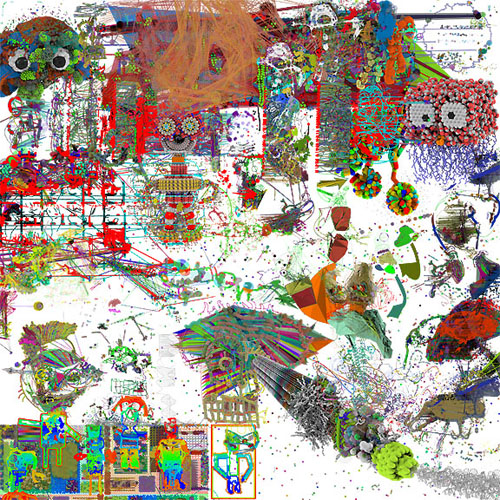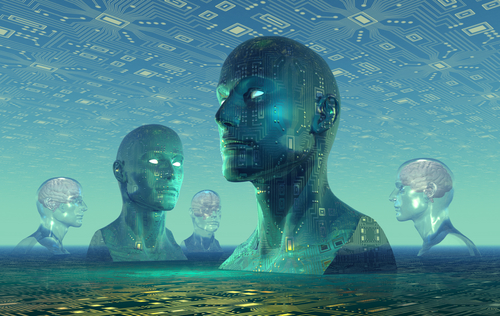The following article was written by Natasha Vita-More in response to Athena Andreadis’ article, "If I Can’t Dance, I Don’t Want to Be Part of Your Revolution!"
“Dancing in all its forms cannot be excluded from the curriculum of all noble education; dancing with the feet, with ideas, with words, and, need I add that one must also be able to dance with the pen?” (Nietzsche)
It is a breezy summer evening, as I sip a glass of wine after tending to the garden, romping in play with my dog, meditation, exercise, and finally engaging in the lusciousness of flirting with my husband, I am alone at last in my study.
How ironic it is that Athena Andreadis views transhumanism as “… deeply anhedonic, hostile to physicality and the pleasures of the body, from enjoying wine to playing in an orchestra …” in her article “If I Can’t Dance, I Don’t Want to Be Part of Your Revolution!” posted on on the Sentient Developments blog.
This response to Andreadis’ article is a well-intended and heart-felt defense of transhumanism in its appreciation and concern for human body and its activism toward human enhancement.
In that we are human with a biology, it makes sense to be biologically healthy, largely because transhumanism is, and always has been, closely linked to the field of life extension. With this said, it is true that transhumanism is more widely known for its vision of a posthuman future—the technological singularity, superintelligences, uploading, distributed existence, etc. Transhumanism is also known for its critical thinking about the future—including human rights, the Proactionary Principle, overcoming bias, environmental and ecological issues, techno-democracy, friendly AI, etc. Nonetheless, I wonder why there is less public attention directed toward the vitality and intelligence behind transhumanists’ emphasis on health and well-being. If one were to scan the most recent publications, topics on health and fitness seem to be missing. It was not always this way.
(Yacov Sharir)
Transhumanism Health & Body
“Flex the mind, flex the body” at one time (probably around 1997) was one of many transhumanist mottos. We were devoted to regenerative medicine and thought that if a person were physically fit, intellectually disciplined, and spiritually alert; we would be practicing a type of “Zen in the art of superlongevity.” Like Pirsig’s Zen and the Art of Motorcycle Maintenance (1974), we tried to encapsulate a perception of the world that embraces the rationale and the dream. As an underlying tenet of transhumanism—health and well-being as logical and as an ideal are indispensable. How could it be otherwise?
Two well-known computer scientists, Ben Goertzel and Peter Voss, agreed. In 1996, Voss writes: “It [extropy/transhumanism] comprises long term physical and emotional health, fulfillment, and happiness; not wasting our lives on irrelevant or unpleasant tasks.” Over ten years later in 2008, Goertzel states: “… the Extropian Ubermensch ‘will exude benevolence, emanating its excess of health and self-confidence.’
Unlike Andreadis’ view that transhumanists harbor disdain for the human body, in the mid-1990s transhumanists were criticized for being too body conscious—too focused on health—too physical, too sexy: Let me gently poke a little fun at ourselves by quoting some journalistic comments:
“… even as a youth, More sought longevity, starting a vitamin regimen at age 11; at 15, he started meditating and lifting weights …”(Icon Magazine 1998)
“Certainly Max looks fit … he has just been through an extensive program of physiological testing at the Kronos Clinic …. Both are muscular and voluptuous, Natasha’s body certainly makes an impressive advertisement for longevity.” (LA Weekly 2001)
“So journalists played up the looniness of their ideas … Max and Natasha’s body building, supplements, antiaging routines.” (Rapture 2003)
“Vita More bodybuilding guru …”(Wired 1997)
“Natasha’s case age seems to have become blurred, confused, to some extent even vanquished.” (LA Weekly 2001)
“... superhuman object of desire …” (The Atlantic 1998)
We did not ask to be reflected with admiration, exaggeration, or disdain. We, like many transhumanists, simply enjoy working out. Of course we also want to enhance our minds and bodies to extend our lives.
What could be more valuable for superlongevity than knowing about what our bodies need to be healthy? Nothing, at least for the time being, later we will have other issues to contend with—in a posthuman world. We can hypothesize about it all we want, but the game is all about staying alive. It always has been about survival.
In 2000 I presented a paper at Longevity Bootcamp, sponsored by the Maximum Life Foundation, a transhumanist organization. The paper revealed The American Council on Exercise (ACE) report from the Surgeon General’s office, which stated that: 60% of American adults exercise only once in a while; 25% never exercise; six out of ten resort to medications to feel better; one-third are overweight; 14% suffer from depression; and two out of five will die of heart disease. In a call for awareness, my paper set out to suggest that by 2050 there will be one million people over 100 years old, a notable increase from the 40,000 centurions alive in 1998. This longevity is even more striking when compared to the normal life expectancy at the turn of the last century (1900s)—which was just 49. Further the paper presented a forecast that of those who are 65 then: 75% will reach 80; 60% will reach 85; 41% will reach 90; 3% will reach 100 and 2% will reach 105.
Transhumanism, in its socio-political understanding of the baby boomer generation approaching an old age and the health needs for such a growing segment of the world’s population, actually was and continues to be realistic about the need for public awareness of health and fitness.
At the inception of the modern philosophy transhuman members of Extropy Institute, and later some members of WTA, were highly proactive about health and fitness.
Roy Walford’s books Maximum Life Span and Beyond the 120 Year Diet were required reading for many transhumanists. But it was not just Dr. Walford’s books that were inspiring, Roy, until he could no longer exercise, worked out at World Gym in Venice, was a unique combination of scientist and artist—his home exhibited images of bodies engaged in dance, yoga and sex alongside scientific research. Chris Heward, formerly Chief Scientist at Kronos Lab in Scottsdale Arizona, was a long-time health enthusiast as well, especially the Gracie style of Jiu-Jitsu.
There are a number of transhumanist writings on pro-body exercise, fitness and sexual freedom. Martine Rothblatt’s The Apartheid of Sex not only discusses the freedom of gender, she also provides a source of knowledge about our sexuality. Ray Kurzweil’s Fantastic Voyage provides a health consciousness and valuable source of information nutrition and supplements. One on One Fitness, which I co-wrote with Leigh Christian, my collage as a personal trainer and sports nutritionist, is a personalized exercise and nutrition routine.
Yet, it almost frightens me that I would have to resort to naming those who are athletic, but I feel I need in stressing the reality of transhumanism and enjoyment of exercise, sports, and dance.

Speaking of dance, and in reflection for a moment—it was so many years ago that I did dance with the Birmingham Dance ensemble in the Opera Tannhäuser. I was not really very disciplined and favored an interpretive movement—like dancing to the sunrise at the rim of Haleakala, dancing in harmony with the waves in the South Atlantic Ocean or to the desert-blown sands of Monument valley. I have never stopped dancing, it simply has taken on different rhythms and steps. And we need to dance with our ideas, words and pen—which transhumanists do take seriously.
Cyborg vs. Transhuman
Perhaps here is a point in my thinking that needs to be acknowledge—the different rhythms and steps of human evolution and bodily enhancement. We might discuss the issue of the transhuman vs. the cyborg. Even though most authors and academics have not carefully addressed the distinctions between the two, there is a clear distinction between the “cyborg” and the “transhuman”. Simply put, the cyborg is a cybernetic machine-man. The transhuman is a transitional stage of transformation of human enhancement. Cyborg = a fixed semi-mental cybernetic being with no destination; transhuman = an unfixed semi-bio enhanced being actively extending life and evolving. But perhaps I am incorrect here. James Hughes’ Citizen Cyborg and his writings on the notion of a “cyborg Buddha” may contradict me. Nonetheless, I believe we are in sync of the transhumanist vision of neurological enhancement, be it cyborg or transhuman.
Addressing Athena
For over twenty years, my practice and theory, while transdisciplinary in scope, have been located precisely and resolutely within the field of transhumanism. I have tried my best to listen to and understand the different flavors of transhumanism and to identity the rhizome growth of interconnected interests and beliefs, which push and pull transhumanism in varied directions. Nonetheless, rooted firmly in the philosophy of transhumanism, the idea of well-being in body and mind is, and continues to be, essential to the core of transhumanism. Whether or not specific individuals who call themselves transhuman or transhumanist represent this understanding is their choice. Yet, if not, they are not responsive to the fullness of the philosophy.
The fact that journalists often select images for their publications which are more cyborg-terminator in scope than transhuman, and therefore often lacking in sensuality, warmth, wellness, and well—lovely, ought to be taken seriously. Even if asked to, why would a journalist generally represent a transhumanism as happy, loving, and nurturing? Journalists and their editors will do as they please to sell their publication, and that visual is often dystopic and fearful. One bad image equals a thousand copies of that same bad image. The same circumstance applies to quotes taken out of context in interviews, articles and essays, and even academic papers.
Alas, I agree with Andreadis in that I do not want to go into the future without being able to move to the music. I would like to address specific claims that Andreadis makes:
Andreadis writes: “Their words contain little color or sound, few scents, hardly any plants or animals. Food and sex come as pills, electric stimuli or IV drips; almost all arts and any sciences not related to individual enhancement have atrophied, along with most human activities that don’t involve VR.”

Rather than taking this claim apart statement by statement, which I could do, I would rather focus in on one particular issue—that “almost all arts and any sciences not related to individual enhancement has atrophied …”
Looking into transhumanist arts and sciences, I can easily identify numerous examples of vibrant color and evoking sounds. The Exemplar collection of visuals, notably “DNA Breakout”, is a prime example of rich colors depicting a transhumanist future. The piece “Walkabout”, which takes place in a rose garden and microscopically it draws parallels between molecular infestation of microbes, but the visuals of the entire project is encompassed soft pinks and brilliant orange colors, and “The Aesthetics of Memetic Evolution”, graphical narrative animation, etc.
Walkabout
While some of these examples do pertain to human enhancement in one form or another, transhumanism is not so limited in its visual scope. Media arts involve the mediums of visual art of sculpture, graphic arts, filmmaking, videography, and interactive gaming, installations, immersive design, dance and theatre, for example. The storylines are not exclusive to science fiction, but even if there were—they revolved around all our human emotions, no matter the biology or synthetic form.
Andreadis further claims, “If a body is tolerated at all, the ideal is a mixture of metal and ceramic ….” Fair enough. Many images do depict a modern, streamlined figure. However some do not. The dvd “Bone Density” shows a transhumanist form which is covered with hair follicles and there is no sign of metal or ceramic particles.
Aesthetics of an Enhanced Existence
It is not that the times have changed for transhsumanism, it is that now the medicine, science and technology that we dared to dream about many years ago are actualizing. The idea of human enhancement is here.
The acronym NBIC has become fairly mainstream. Does that mean that we will be cyborgized terminators of a Noosphere’s conglomerate mindthink? No. It does not. It means that we will continue expanding our human, biological senses to further explore and interact with the universe around us. Whatever shape or form emerges will be more than a machine with wires—it will be the creation of the new interpretations of the visions of Leonardo, Matisse, Chanel, Versace, and whose media will emerge from the nano-bio-info-cogno and become more—an evolving NBIC+. Critics ought not to be so stern in nature and attitude to assume that the artists, designers and engineers of our future selves will be limited by the 20th century sketches of a cyborg future. We must have a little respect for the creative multi-media and transdisciplinary fields that will emerge as the medicine, science and technologies advance.

No matter the bodily or substrate style, sensorial pleasures are aesthetic characteristics relative to a posthuman future. Aesthetics of radically enhanced existence seeks to elucidate both the nature of experience itself, and the essential moments of our multi-selves’ perceptions of experience.
Umberto Eco asked,“is beauty something ontologically self-subsistent, which gives pleasure when it is apprehended? Or is it rather the case that a thing appears beautiful only when someone apprehends it in such a way as to experience a certain type of pleasure?” Beauty can be one, the other, or both ways—taking it into state of multiplicity. The idea that historically theories had to be located in one field, one argument, one result changes to the proactive prospect that it is not an either or scenario, but an array of possibilities that removes the tension of contradictions.
Works of art which will help determine our future also affect our perceptions and how we build forms, environments within which to exist. No doubt this will affect our values which govern our own sense of life, dignity and social circumstances. They also invite art works which will engage the enhanced existence media for semi/non-bio bodies, and further sustain our sense of style.
Transhumanist Intelligence
Andreadis further claims that “It’s a transhumanist article of faith that intelligence can and must be augmented – but there are many kinds of intelligences.” Here I pause. First, it is true that transhumanist support the idea of augmenting intelligence, as a fact, not an article of faith. Second, transhumanists are fully aware of the different types of intelligence. Emotional Intelligence: Why It Can Matter More Than IQ has been on the transhumanist reading lists since for over a decade, along with Flow Creativity: Flow and the Psychology of Discovery and Invention. My own paper “Ageless Thinking” presented at the Resources for Independent Thinking in 1996 discusses intelligence, the body and sexuality, and which proposes a very different view of transhumanist body and attitudes than what Andreadis suggests in her article.
Like Andreadis, I too believe that our bodies can be improved. Where we obviously differ is Andreadis’ belief that the carbon body is essential to be empathic and loving. My thinking is that we do not have to be sequestered to one body, be it carbon/biological or otherwise. Why limit our choices? It is true that today many humans do not exist in one bodily form. Many co-reside in virtual habitats in avatars. While this venue is currently anything but seamless, the odds that the alternatives for co-existing in multiple bodies in multiple environments is more than high.

I thank Athena Andreadis for her honest appraisal and provoking article, which represents what many others assume to be a characterization of transhumanism. Nonetheless, it has never been my own, nor the vision of those I know and have worked with for decades and with whom I pioneered the cultural/social movement of transhumanism. The dance of improvisation: requires skill, diversity, flexibility and stamina—much like life itself.
“Dancing is just discovery, discovery, discovery.” (Martha Graham)
“The free expression of the hopes and aspirations of a people
is the greatest and only safety in a sane society.” (Emma Goldman)
(Elif Ayiter)
is a fellow of the IEET, a media designer and futurist.
 Michael Anissimov is guest blogging this month.
Michael Anissimov is guest blogging this month.



![Shane Hope: Yes, but [grey goo] will be our children.](http://farm4.static.flickr.com/3351/3658661680_f785f6164a_o.jpg)





















